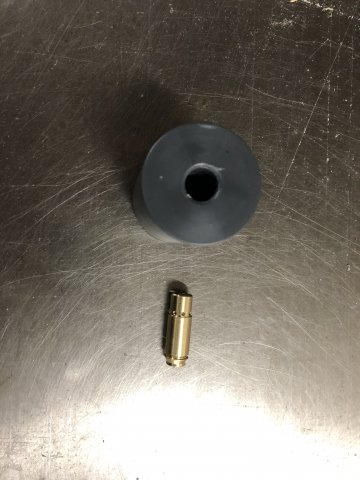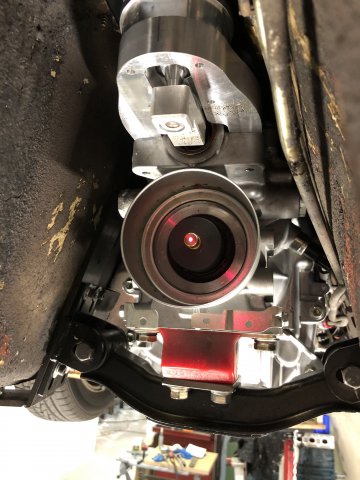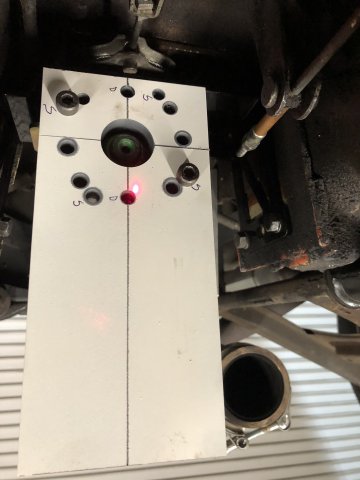-
Posts
1343 -
Joined
-
Last visited
-
Days Won
53
Content Type
Profiles
Forums
Blogs
Events
Gallery
Downloads
Store
Everything posted by Derek
-
Just save yourself some time and buy a set of mine:) $110.00 plus shipping.
-
Correct. the 45 ACP bore laser is 12MM OD.
-
Yea that's why I made the slip adapter. The other methods with a magnet didn't seem to be accurate.
-
Motor tilting back/down. Pinion flange pointing up. Technically that means the pinion shaft is tilting down according to the literature I read.
-
So I made a laser alignment tool based on a few Ideas I gleaned from the forum. I made a slip collar that fits over the CD009 output shaft that holds a 45ACP laser bore setter. I'm using this for the horizontal alignment. Works well. I made a target that has a couple of alignment lines. The bottom is parallel/perpendicular to those lines so you can use a level to get it plumb. I then proceeded to drill so many holes in it that it's almost useless:) The key word here is almost. That was a far over to centerline as I could get it. I need to rework either the Diff mount or the trans mount to get it any further but it's only about a half a degree so I may live with it. I'm running the Technoversions RT mount and I switched to the top mount instead of the stock bottom. This brought the pinion angle down to 2.8 degrees. The transmission is at 2.9 degrees so I'm pretty satisfied. Hard to tell if it made much of a difference but the math says it should.
-
I bought both off of ebay. The 3.9 was supposedly out of a 2004 with under 36K miles. It has a noticeable whine at 50 which leads me to believe that under 36K was wrong. The 3.54 was out of a 2019 with 19K and it looks like it. I was learning to live with the 3.9 but then the 6 speed made me want a 3.54. Buying a used rear end is a crap shoot.
-
I'm leaning that direction as well. I have a block that will work at 89 but it's on the edge. I already have enough to worry about:)
-
If it's any consolation I'm envious of the 3.2. Things keep getting in the way. Although the crank is done so that is a pretty big part of it.
-
I'm doing exactly the same bottom end and after hearing that now I really need to move it along. Sounds great. You know a KN20 head would solve that pesky power drop off problem:)
-
Preaching to the choir Thank goodness for a twin post lift and an air conditioned shop. Nor do I. I based all my calculations on 75mph cruise speeds. I then drove the car at the revs that the calculator listed for the different ratios to get a feel for it. The 3.79 first gear gives some options as far as final drive choice in my opinion. Yea the CD009 isn't exactly known as a silent gear box by any stretch. My main complaint is in neutral clutch out the input shaft noise is a little bothersome.
-
In the video I'm running a 3.9. It pulls out of the hole really well even with my low HP build. The problem for me was on the highway it was taching too high for my comfort. The motor is pretty quiet down below 2800 or so and at 75 mph it was a little loud for me. I pulled the 3.9 and put the 3.364 back in. As expected the highway RPM's came way down but out of the hole was lacking. If I had my 3.2 built It probably would be fine. I just bought a Subie 3.54 LSD and I think (hope) that it will be my forever differential. I use this drive train calculator to play around with and it really helps. It's for 4WD so ignore the transfer case section:) It's nice because it has two columns and you can easily compare between different combinations. http://www.grimmjeeper.com/gears.html Instructions: http://www.grimmjeeper.com/gears_instructions.html CD009 Ratios: 1st 3.79 2nd 2.32 3rd 1.62 4th 1.27 5th 1.0 6th .79
-
Now you tell me:) So I ended up buying a brand new input shaft and bearing for testing and it's worked out really well so far. Chris from Godzilla has done some test fitting with the bell housing I sent him and I have the data I need to make the final tweeks to the pattern. I'm doing that tomorrow and hopefully will have the patterns back down to the foundry next week so I can get in line. I'm ordering 10 for the first go round. Chris is handling pre orders and keeping track of who wants one so if you want one I would contact him. I will be selling them directly as well but I'm encouraging people to deal with Godzilla since I have my hands full.
-
I was doing the installation instructions for the CD009/L6 bell housing. I started on the cross member section and that is when I researched drive line angles. As soon as I walked over to the car an looked at the pinion flange I realized that it was a lot more than 3 degrees. I'm going to bring it down to match the engine and see how it goes.
-
Agreed. I think the more critical number is that the output shaft of the transmission and the input shaft of the diff are the same or nearly so. The video shows pretty clearly how an elliptical movement can be generated by miss matched angles. The Tremec app measures the output shaft angle, the drive shaft angle and the pinion angle and then gives you a report if they are within specs.
-
I think the laser is appropriate for horizontal alignment. but an inclinometer is a much better choice for vertical. The 5 degrees I measured was with my Subbie 3.9 diff installed. I have since put my stock diff back in to test out how the 3.364 ratio plays with the CD009 but like an idiot I didn't check the pinion angle. I'll be pulling the drive shaft again soon and I'll check the angle again and see what I get.
-
The Tremec app works really well. And it's free:) I exchanged a PM with Madkaw over on classicz because I saw a post he made on it. He said he measured his and it was 2 degrees so the plot thickens. Everything I read says no more than 3 degrees. I'm going to double check my measurement and see what gives. Here is a video showing the importance of having the same angles on the transmission and pinion.
-
I saw those and may make one at some point to check horizontal alignment. Tremec makes a pretty good app for taking measurements with your phone and it does the math for you. The 5 degree pinion angle is so far out that until I get some clarification on that I'm not going to change anything. It seems they had to have had a reason for designing it with 5 degrees tilt . I wonder if it was trying to correct a vibration problem. My 73 has the stack of steel plates under the diff X member so there was for sure some sort of issue.
-
Actually I was already thinking what I would do if I wanted to rework the cross member. That looks like a practical solution for sure. I think the stock angle on the motor was right around 3 degrees. When I was working on the 6 speed install I kept looking at the pinion angle and thought it was odd. There is a fair amount of data out there on the principles but my understanding is no more than 3 degrees on either angle and no more than 1 degree difference between them. There is more to it than that but that's the general gist. The 5 degree pinion angle is way out. I have heard of dropping the pinion flange so that under hard pulls it lifts into position but it's 2 degrees out of spec even before torque is applied.
-
So since I put in my CD009 I decided to do some checking into proper driveline angles. The transmission output shaft is right around 2.7 degrees which is good from what I read. but the pinion angle in it's factory position is 4.9. Anyone ever delved into this? I did some searches but I didn't see much about it. Is there a reason why Nissan put so much angle in there? I have a Ron Tyler style mount and I can top hang the diff and dial in the angle but before I do that I wanted to hear what you all had to say on it. Thanks Derek
-
The 04-05 3.9 STI diff I believe is a Suretrac. No clutches. At least that is what mine is. From what I understand it's more like a Quaif unit.
-
I know it's a long shot. Looking for a used input shaft for a CD009 6MT. The critical parts of the shaft are the pilot area and the front bearing. I need to make a QC test rig for the bell housing.
-
I seriously don't think I would be doing this stuff if HybridZ didn't exist. It's really sad that people have taken to FB to find answers as opposed to going to forums. I read some stuff there and just shake my head at a lot of the answers. Back to the CD009. Working great. CD009 transmissions are notorious for gear rattle in neutral with the clutch out and mine is no different but other than that functionally it's fine. I think for my driving desires the 3.9 is a tad too much. The revs are a little high in 6th. I think a 3.54 would be a better choice. But the gear spread from 0-50 MPH is really a lot of fun in town. I think I'm going to put my stock rear and axles back in to get a feel for that and see how it goes.
-
Actually I'm glad I have to cut the tunnel. It's my way of flipping off the series one purists:) I got a six speed and you don't na na na na naaa na.
-
Thanks for all the kind words and what I think is a marriage proposal from Seattlejester. I love you too but you still have to pay full price for a KN20. Nice try though. Crap I missed a picture when I did the post. So I machine the bosses on the Nissan cover to the same level which keeps the bell housing parallel to the transmission. The three dowels keep the bell housing centered on the input shaft. Longer M8 bolts sandwich the whole rig together. If you look closely you can see the new boss for the clutch pivot so that it is on the correct side. The internal ribbing probably is over kill but I thought it looked cool. Every conversion system other than Hokes that I know of uses these bolts as the mounting point. From what I can tell I'm the first to use the existing cover. as part of the system. As part of the assembly procedure I recommend a dry fit with no clutch or pressure plate and the transmission in gear. Bolt the transmission to the motor with a pilot bearing installed. You should be able to turn the output shaft by hand if the input shaft is riding in the bearing properly. I'm confused by "just paid for the bell housing" I haven't sold any yet. Something else I missed was the fact you have to modify the tunnel just like every other CDXXX conversion. I'm putting the finishing touches on the installation instructions and I'll post the PDF here so people can get an idea of what is involved. Edit: Just talked to Chris at Godzilla. I'm no longer confused:) Well I'm still confused but that is my general state of mind.
-

Twin cam head for the L6 from Derek at Datsunworks
Derek replied to Derek's topic in Nissan L6 Forum
I know a lot of you follow this thread and I wanted to give you a heads up I'm coming out with a CD009 bell housing. I just posted a pretty detailed build thread over in Driveline. https://forums.hybridz.org/topic/131751-cd009-bellhousing-build-thread-warning-lots-o-pics/ There is a bonus video towards the end:) Thanks Derek




